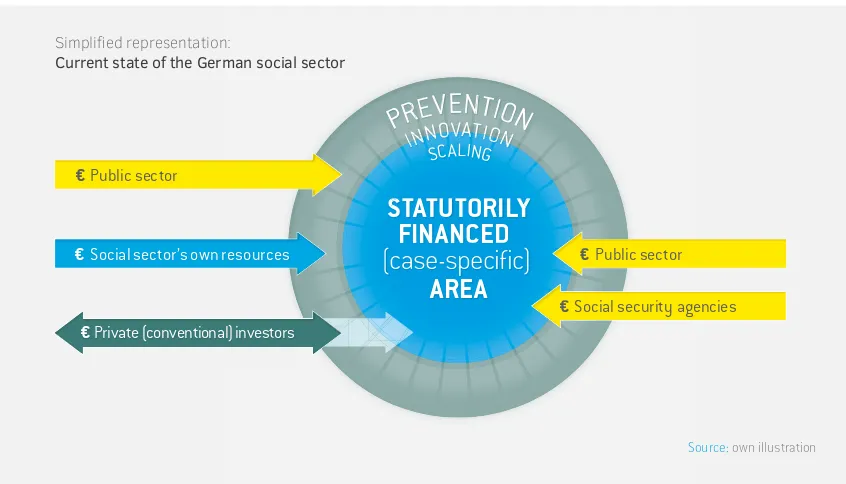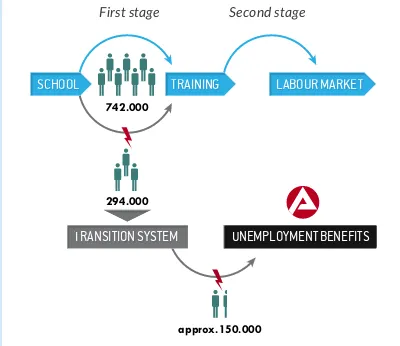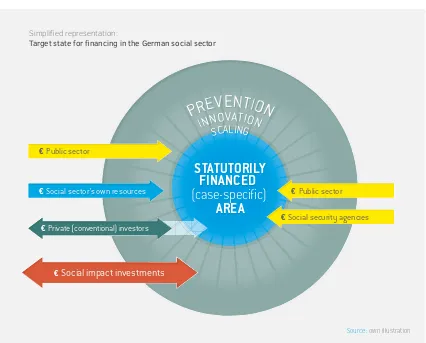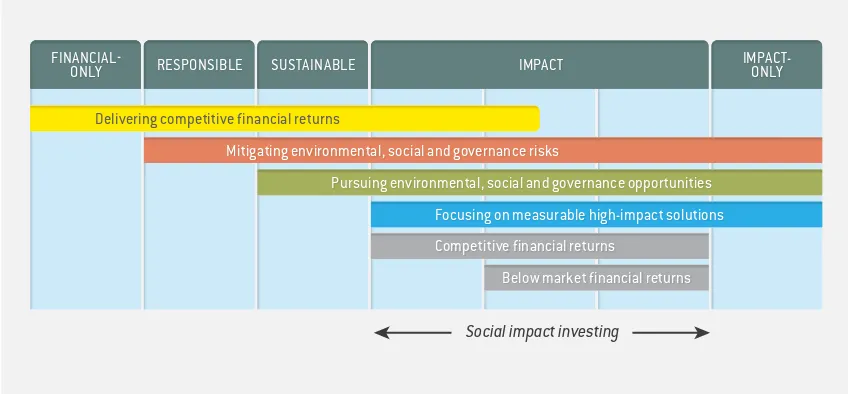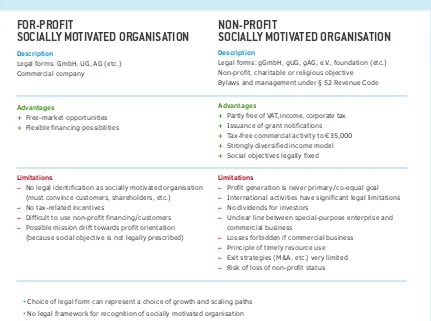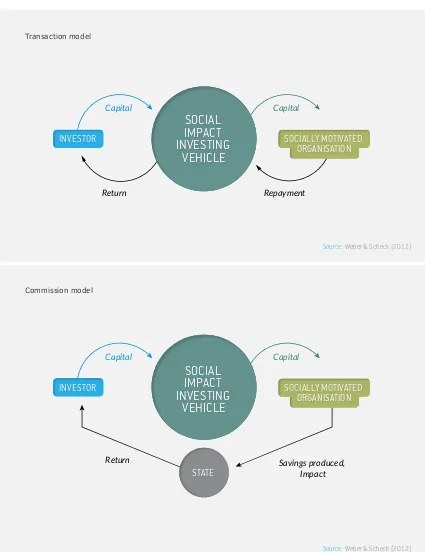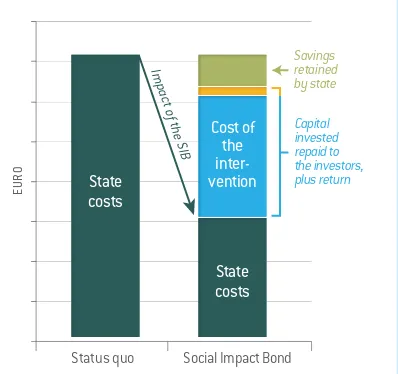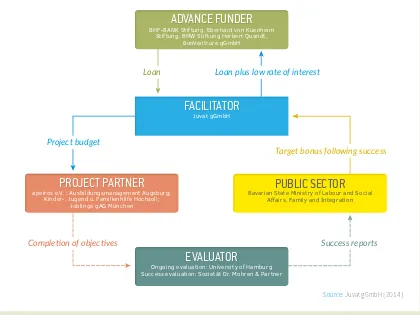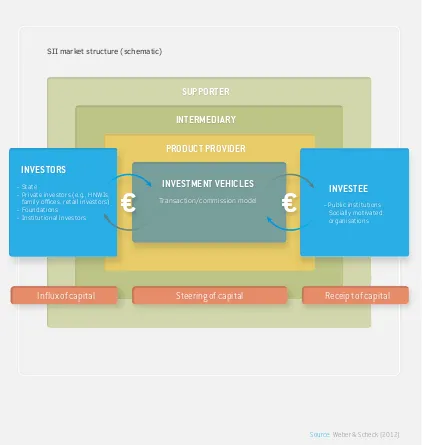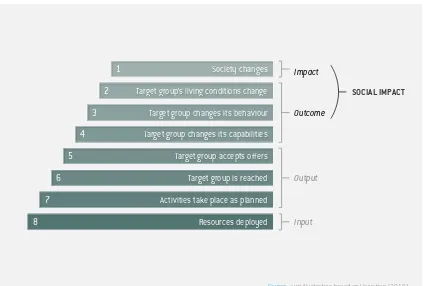Disclaimer
3
TABLE OF CONTENTS
PREFACE . . . 5
MEMBERS OF THE NATIONAL ADVISORY BOARD GERMANY . . . 7
EXECUTIVE SUMMARY . . . 8
INTRODUCTION . . . 11
I. THE DEMAND . . . 13
II. THE SUPPLY . . . 21
III. ANALYSIS AND COMMUNICATION OF IMPACT . . . 49
IV. SOCIAL IMPACT INVESTING IN DEVELOPING AND EMERGING COUNTRIES . . . 57
V. CONCLUSIONS AND RECOMMENDATIONS . . . 63
4
Final report: NAB Germany
INFOBOX
1
Social Impact Investment Taskforce and National Advisory Board: Mission and mandate
The Social Impact Investment Taskforce (SIITF) was established during the United Kingdom’s G8 presidency in 2013. It is made up of state and civil society representatives of the member countries. This independent public-private Taskforce was mandated by British Prime Minister David Cameron to formulate recommendations for the constitution and further development of international markets in which supply and demand for social impact investment capital can be effectively brought together.
Sir Ronald Cohen chaired this Taskforce. He is the founder of the Apax investment group and chair of the UK Taskforce on Social Investment, which was active between 2000 and 2010. The German government was represented within the Taskforce by Susanne Dorasil of the Federal Ministry of Economic Cooperation and Development (BMZ). Germany’s civil society sector was represented by Dr. Brigitte Mohn of the Bertelsmann Stiftung.
Each of the G8 states, including Germany, participated in the creation of National Advisory Boards (NABs) at the national level. In Germany, this board was composed of representatives from the social sector, financial sector, foundations, academia and public sector (see page 7). The German NAB provided the international Taskforce with information on the specific circumstances in Germany and its members’ experiences with private investment capital within the social welfare system. In addition, it offered information on experiences related to German social impact investment initiatives in developing and emerging countries.
5
PREFACE
Dr. Brigitte Mohn
Germany is facing costly challenges. Social, demographic and ecological developments require us to not only support proven solutions within our social sector, but also to test new ideas and approaches. If these prove to be successful and effective, the next step must be to ensure
that they are implemented in a manner befitting the existing system. This is impossible without the strong commitment of the professionals and volunteers working within our social sector. In order to ensure they have the necessary resources available to them, I believe the financing options in this sector must be expanded.
Over the last year, an international working group that emerged from a meeting of the G8 countries in summer 2013 has been intensively investigating the potential development of additional financing sources for the social sector. Its focus has been on the mobilisation of private investment capital in order to finance the most promising new models for solving social problems. The novelty of this approach lies in starting with a shared understanding of the problem, defining common goals, and seeking to create solutions through a division of labour involving various sectors. By drawing on private capital, we can expand our financing options. In this way, the social systems of developed welfare states can be strengthened. Moreover, using similar approaches can also support developing and emerging countries.
Special thanks go to the members of the German National Advisory Board for their willingness to examine the use of social impact investing both within Germany and in overseas investments with German origins. It is of great significance that actors from the social sector, financial sector, foundations, academia and the public sector were able to agree on looking towards a shared goal — the financing of positive social impact. Different worlds came together here and were willing to learn from one another.
6
Preface Final report: NAB Germany
Each day a huge number of motivated and talented people work on the development and dissemination of solutions to social problems, be they based in existing social purpose organisations or in start-ups. Socially motivated investors are looking for new forms of impact-oriented activities. New advisory services are appearing with the aim of bringing together demand and supply. To make genuine progress, these investors, investees and intermediaries need targeted support, including an enabling policy environment.
We are at the beginning of a long journey. I am pleased that we are on this path together and very much hope that this report will serve as a starting point for further debate and decisive action.
Dr. Brigitte Mohn
Chair, National Advisory Board (NAB) Germany
7
MEMBERS OF THE NATIONAL ADVISORY BOARD GERMANY
Dr. Brigitte Mohn Bertelsmann Stiftung (chair, international Taskforce member)
Susanne Dorasil Federal Ministry of Economic Cooperation and Development (international Taskforce member) Dr. Georg Allendorf Deutsche Bank
Havva Avci-Plüm Ministry of Labour and Social Affairs, North Rhine-Westphalia (observer) Dr. Ingo Ballschmieter Bertelsmann Stiftung
Jake Benford Bertelsmann Stiftung
Maren Bianchini-Hartmann BMW Stiftung Herbert Quandt and Eberhard von Kuenheim Stiftung
Dr. Mariana Bozesan AQAL Capital
Florian Erber Social Venture Fund
Jörg Freese Deutscher Landkreistag
Dr. Markus Freiburg Financing Agency for Social Entrepreneurship (FASE)
Thomas Goldfuß GLS Bank
Roland Groß Deutsche Gesellschaft für Internationale Zusammenarbeit (GIZ)
Dr. Peter W. Heller Canopus Foundation
Diana Hollmann Deutsche Gesellschaft für Internationale Zusammenarbeit (GIZ)
Marco Janezic Blue Ribbon Partners
Dr. Thomas Jetter Soros Economic Development Fund
Nadine Köllner Vodafone Stiftung Deutschland
Norbert Kunz Social Impact Lab
Dr. Nannette Lindenberg German Development Institute
Cornelia Markowski German Association for Public and Private Welfare
Wolfgang Meyer Sozialwerk St. Georg
Dr. Markus Nachbaur Stiftung Liebenau
Tobias Nowoczyn German Red Cross Association
Pieter Oostlander European Venture Philanthropy Association (EVPA)
Dr. Andreas Rickert Phineo
Prof. Dr. Henry Schäfer University of Stuttgart
Prof. Dr. Barbara Scheck University of Hamburg
Michael Schneider Deutsche Bank
Michael Sommer Deutscher Caritasverband
Dr. Volker Then Centre for Social Investment, University of Heidelberg
Dorothee Vogt BonVenture
Carl-August Graf von Kospoth Eberhard von Kuenheim Stiftung
Ingo Weber The GIIN Europe and LeapFrog Investments
Melinda Weber Impact in Motion
Volker Weber Forum Nachhaltige Geldanlagen
Berenike Wiener Association of German Foundations
Sylvia Wisniwski Finance in Motion
Bettina Windau Bertelsmann Stiftung
8
Executive Summary Final report: NAB Germany
EXECUTIVE SUMMARY
► Social, demographic and environmental developments have triggered a search for new sources of
financing in order to develop and implement solutions to social challenges; this search is taking place internationally as well as in Germany.
► Social impact investments (hereafter referred to as SII), known in Germany as “Wirkungsorientiertes
Investieren (WI)”, are investments whose focus goes beyond purely risk and return. Rather, they
intentionally target specific social objectives along with a financial return and measure the achieve-ment of both. The core idea behind SII is thus to build a bridge between positive social impact and the allocation or deployment of capital.
► In Germany, SII offers the opportunity to channel “impact-seeking” capital into areas of the social
sector where the need is greatest.
► Germany’s social sector requires investments for activities related to prevention, innovation and
scaling up. Despite the country’s highly developed welfare system, there are significantly less finan-cial resources available for these types of measures compared to the statutorily funded areas of the social system.
► The use of SII should always be complementary to existing financial resources and should not trigger
a debate over the distribution of public spending or indeed cuts. Rather, SII should broaden and strengthen the social sector’s financing system. Once impact has been demonstrated, measures financed through SII can be considered for guaranteed financing as codified in social law. In particular, the use of SII should not lead to the privatisation or commercialisation of state-guaranteed public services.
► The German market for social impact investments currently finds itself in a phase of innovation
driven by pioneers in the field. The next step towards integrating SII into the social sector’s financ-ing system will require a systematic proof of concept in one or more selected fields of the social economy.
► For a systematic proof of concept to occur, appropriate support structures for funding recipients,
funding providers and intermediaries are required. Philanthropic capital will play a key role in the innovation and proof of concept phases.
► At this early stage it is necessary to create knowledge-building and networking opportunities to foster
9
► State supported SII funds, perhaps with a regional focus, can create new incentives for the
implemen-tation of prevention, innovation and scaling up activities in selected areas of the social sector.
► With regard to investors, risk-sharing measures for pioneering social investors will be necessary during
the innovation and proof of concept phases. Public promotional banks and foundations can play an important role in this area.
► In terms of investments outside of Germany, the KfW Development Bank and the Deutsche
Investitions- und Entwicklungsgesellschaft (DEG) are particularly active on behalf of the federal government, aiming, among other things, for positive social and environmental impact in developing and emerging countries.
► Internationally, there are already a number of established actors and instruments facilitating social
impact investments in developing and emerging countries. Sensitising German investors to these activities and enabling an exchange of information about first-hand experiences could help to advance the market further.
► Investors are showing a growing interest in the social impact associated with investment capital,
suggesting a basic affinity with the aims of SII. Although the degree to which the investment community is ready to invest in SII has not been comprehensively researched yet, a current and ongoing survey offers some initial empirical findings:
– Foundations see SII as an interesting new investment option while wealth managers remain critical of below-market rates of return. In terms of grant-giving, an investment with positive returns is fundamentally difficult, as the profit would create an (unintended) business operation. The provision of legal certainty through appropriate regulation is thus urgently needed. This is particularly true for regulations pertaining to taxes and foundations.
– Private investors, especially high net worth individuals, see SII as a good way to achieve positive and measurable social impact with small initial investment budget. In this regard, private investors are willing to accept below-market returns for significant periods of time. At the same time, however, there is a relatively small number of suitable products or robust investable propositions currently available. The opportunity for investors to personally identify with their investment and to see their impact at the local level will also make SII interesting for retail investors in the future.
– For professional investors, the overall understanding of the interplay between risk, return and social
impact is of crucial long-term significance. The integration of SII into multi asset portfolios can only be effected on the basis of such an understanding.
► Going forward, it is investors and financial intermediaries in particular who will need to acquire the
10
Introduction Final report: NAB Germany
INFOBOX
2
The OECD and the international development of social impact investment
The Organisation for Economic Cooperation and Development (OECD) in cooperation with the Social Impact Investment Taskforce (SIITF) and the National Advisory Boards (NABs) is currently preparing a broadly conceived study on the role of SII within the financing systems of developed industrial countries. To this end, the needs of the social sectors of OECD countries are being closely examined. More specifically, the study examines the evolution of this approach to financing and its visible trends, drawing a parallel with the evolution of venture capital markets. As a result, the study further develops the conceptual understanding of SII and proposes several relevant methods of data collection and presentation. More significantly, however, the study makes proposals for creating an enabling policy environment for SII markets.
11
INTRODUCTION
The search for new resources
Fewer citizens, more individuals with social needs and yet empty coffers: The consequences of this predicament are felt in particular by Germany’s municipalities and their partners in the social sector. As a result, the need to develop new solutions is greater than ever. At the same time, Germany is not alone in facing the challenge of rising social costs on the one hand and a decline in funding options to tackle them on the other. It is against this background and at the initiative of the British government that the topic of social impact investing found its way onto the agenda of a meeting of the G8 countries in June 2013.
SII — in German, “Wirkungsorientiertes Investieren (WI)” — are investments whose focus goes
beyond risk and return. Instead, they intentionally target specific social objectives along with a financial return and measure the achievement of both. This bridge which SII builds between the financial and social sectors should be constructed in the public interest and should contribute to a sustainable society by strengthening the social sector.
12
Introduction Final report: NAB Germany
Can social impact investing strengthen Germany’s social sector? How can SII originating in Germany and aimed at developing countries be strengthened? This report offers an initial assessment of this funding approach within the German context. It is guided by the following questions:
I : Demand for funding:
Where exactly within Germany’s system of social services and among socially motivated organisations is there a need for social impact capital?
II : Supply of financing:
Under what conditions can social impact investment capital be mobilised to finance
social impact in Germany and in developing and emerging countries?
III : Analysis and communication of impact:
How can the factors driving success in social programmes be captured and
communicated in order to attract private actors to the SII sphere?
IV : Enabling conditions:
What support structures are necessary in order to facilitate or strengthen the use of SII both domestically (in Germany) and internationally (investments originating from Germany)?
13
CHAPTER I.
The demand
Prevention, innovation and scaling up
in the German social sector
Germany is facing costly demographic and social challenges. Today the expendi-ture for health, education and social issues is rising faster than GDP — in the case of forecasted health spending through 2025,
perhaps even twice as fast.1 Even in terms of
providing a consistent level of social services,
funding gaps are already visible today.
Representatives of the German social sector attest to the sector’s progressive underfund-ing, confirming the suspicion that current funding levels will be insufficient in the long
term.2 The consequences of these emerging
cost pressures are witnessed daily by
socially motivated organisations.3 Grants are
being reduced or discontinued and service
payments are being kept to a minimum.
These circumstances are placing considerable pressure on all the parties involved to square the growing demand for social services with increasing budget restraints — whilst at the same time increasing social impact. Associations representing social organisations point to the fact that there are limits to rationing and efficiency gains for the types of services they deliver; at the same time, their own resources, used in the past to fill funding gaps, are virtually exhausted.
1 Accenture (2013)
2 Accenture (2013); Bertelsmann Stiftung (2013)
14
Chapter I The Demand Final report: NAB Germany
Prevention, innovation and scaling up activities are underfunded
Given the growing demographic and social challenges and changed financial situation, there is an obvious shortfall in funding for preventative measures that can avert downstream costs, for the innovation needed to develop new solutions, and for efforts to roll out proven approaches on a larger scale. In the private sector, the need for investment aimed at the targeted development of new products and services is undisputed — it is in fact a recognised prerequisite for a sustainably successful business model. Yet in the social sector, where the market environment is due to change radically over the coming years, there is a lack of financial resources available to develop the targeted and forward-looking models needed to meet future challenges. Indeed, socially motivated organisations’ latitude for action is increasingly being restricted. Such bodies compete for limited financial resources and operate under high pressure to be as efficient as possible. This pressure rarely leads to improve-ments in services and business models or stronger social impact, and ultimately does little to create a better social welfare system.
[image:14.595.97.520.468.710.2]The following graphic illustrates the problem of underfunding in the social sector and distinguishes between two areas: first, the area of so-called ‘guaranteed financing’, in which claims to services and thus access to public resources are supported by a statutorily anchored social welfare system; and second, the areas of prevention, innovation and scaling, largely organised and financed on a voluntary basis.
Fig. 1: Current financing sources in the German social sector
STATUTORILY
FINANCED
(case-specific)
AREA
€ Public sector € Public sector
€ Social security agencies
€ Social sector’s own resources €
Soc
PREVENTION
€
PRREVVENNTIOON
INNOVATION
STATUTORILY
Y
S
Y
S
FINANCED
(case-specific)
AREA
IIIINNNNNNNNNNOOOOVVAAAATTTTIIIOOOOOOOOONNNN
SCALING€ Private (conventional) investors
Simplified representation:
Current state of the German social sector
15
In comparison with international standards, the German welfare state has developed a mature welfare system that offers high-value social security and support services to citizen beneficiaries on the basis of an individual legal right (see inner circle). German social law functions primarily as an individual entitlement to services in this case. Specifically, this means that implementation takes place
across the “Problem recognition — Diagnosis — Classification — Disbursement” process chain. This type
of so-called ‘case-specific’ work is to a large extent fully financed by the existing system; from the perspective of social sector service providers, the challenges in this context do not primarily derive from a lack of financial resources, but are rather the result of the need to increase efficiency and efficacy in the use of existing resources.
Prevention
However, prevention is accomplished through so-called ‘non-case-specific’ work. Through prevention,
individual services or even the overall system of services can be arranged so that an aggravation of the current problems can be avoided; thus, either the use of additional services becomes unnecessary or transition to costlier forms of support can be avoided or delayed. This can include services provided or measures taken for the benefit of multiple categories of people in the social environment; measures for coordinating, facilitating and managing networks; or measures that have a bearing on multiple budgets and areas of law. However, in many cases, prevention can only be accomplished through new types of service provision that cut across traditional dividing lines between funding providers, ministries and levels of government. While prevention is expressly provided for in a number of social legal codes, the further development of the social sector towards a prevention- focused system is constrained by the underfunding of these non-case-specific measures and services.
Innovation
16
Chapter I The Demand Final report: NAB Germany
Scaling
At various points in German social law provisions are made for the annual allocation of resource funding directed towards the innovative development of preventative approaches (e.g. § 135 Social Security Code III, § 3 and § 4 Social Security Code IX ). Moreover, numerous foundations and other organisations in Germany are focused on making social services function more effectively. In many cases, these efforts also produce successful pilot or flagship projects with demonstrated impact. These are, however, often not taken to the next logical level of implementation. This is often due to
the predominance of project-based funding and resulting lack of resources following the conclusion of the pilot phase. The implementation of a consistent strategy to scale up high-impact projects could avert the widespread need to continually reinvent the wheel and would lead to a considerably more
effective use of time, energy and financial resources.4
Your money, my savings
A further challenge for the financing of prevention, innovation and scaling up activities arises from the fact that expenditure reductions achieved are often reflected in the budgets of entities that have not “invested”, rather than in the budgets of those that did. This discrepancy between costs and social returns creates a system of countervailing incentives. Why should the Ministry of Justice invest in recidivism reduction among ex-offenders if the positive financial effects accrue to the social security agencies, for example? And why should a socially motivated organisation invest in home-based care for the elderly in order to delay or even prevent the transition to more costly forms of care if the positive financial effects accrue to the long-term care system, the municipal budget and the housing industry?
Regulated and less regulated...
Against this backdrop, new sources of funding and new funding approaches are becoming increasingly relevant to socially motivated organisations. And yet, access to credit and capital markets will become more difficult for start-ups and existing organisations alike if they cannot offer sufficient equity and security if their expectations of future earnings are not reasonably secure and if they cannot demonstrate an acceptable banking history. Accordingly, funding difficulties emerge when socially motivated organisations that are strong and forward-looking implement a new service concept or business model or wish to roll out proven solutions on a new, larger scale — regardless of the anticipated positive social impact. It is precisely this problem that leads socially motivated organisations to the conclusion that they are not so much hindered in increasing their impact by a lack of ideas but rather by a funding-related problem of implementation.
17
The limitations of case-specific guaranteed financing (inner circle) within the social services and social insurance systems clearly demand an expansion of non-case-specific funding for the support of prevention, innovation and scaling up activities (outer circle). Underlying this need is a widely acknowledged increase in demand for social services as well as pressure to make services more efficient and effective in order to prevent future expenditure. While competition within the social sector is rising, placing increasing pressure on providers to improve efficiency, this competition often fails to lead to the creation of new business models with improved types of service delivery that expand and strengthen the statutory welfare system. Against the background of social, demographic and fiscal trends, the funding conditions for prevention, scaling and innovation appear suboptimal — even unsustainable — going forward. The development of prevention, innovation and scaling up activities must be better supported through new funding conditions in the future.
The crux of the issue
The evolving character of demand is visible in numerous areas of the social sector. It can be illustrated
in two areas of significant social relevance: “Vocational education and work” and “support and care for
SPOTLIGHT
1
Vocational education and work
Comparison across OECD countries shows that Germany’s overall unemployment rate is relatively low and its economy is relatively strong. Nevertheless, as a share of overall unemployment, the country has an above average long-term unemployment rate of 46.2% in comparison to an OECD-wide rate of 33.6%.5 Analyses show that the
main cause of long-term unemployment lies in the lack of training of young people; while the individual risk of unemployment is closely related to a person’s acquired level of work qualification. In 2011, 45% of all unemployed individuals had no qualifications and only 14% of people without a qualification were employed, 6 while 17% (7.9
million) of people of working age7 were without v ocational
training and not in school, study or training at that point. 8
Every year, an additional 150,000 young people leave the education system permanently without a vocational qualification. As Figure 2 shows, about 294,000 school-leavers in 2011, or around 30% of the age cohort, 9 failed
[image:18.595.101.301.488.661.2]to take the step from school to either vocational training or the labour market.
Fig. 2: Transition into the labour market ( 2011 )
UNEMPLOYMENT BENEFITS UNEMPLOYMENT BENEFITS First stage 742.000 approx. 150.000 Second stage 294.000 TRAINING TTRAINING SCHOOL
SCHOOL LABOUR MARKETLABOURMARKET
TRANSITION SYSTEM TTRANSITION SYSTEM
Source: Hausner, Engelhard & Weber (2014)
5 OECD ( 2013 )
6 Weber & Weber ( 2013 ) 7 15 to 64 years
8 Bundesagentur für Arbeit ( 2013 )
9 Klemm ( 2012 )
The transition system consists of educational programmes that enable young people without a degree to com-plete their general- education diplomas and to find a vocational focus, fulfilling the compulsory school attend-ance requirement part-time if necessary. These educa-tion programmes impart basic vocaeduca-tional skills but do not provide recognised vocational degrees — thus, the tran-sition system can be described as expensive, inefficient and unjust: only around 50% of all participants were subsequently successful in entering the vocational train-ing marketplace. Thus, this path is associated with a considerable loss of time for these participants. More problematic, however, is the other half of participants (about 150,000 young people per year) for whom the transitional system’s measures are ultimately ineffective as they, despite significant personnel and time investment, remain permanently without a vocational qualification. 10
This lack of vocational education of young people produces high long-term costs for the state:
• Additional expenditure on the part of social security institutions and public budgets (2012: €53.8 billion, €25.2 billion of which was borne by local authorities).
• Lower revenues through lost wages, income tax or social security contributions (2012: €24.1 billion).11
• Indirect cost factors such as increased health and crime-related costs in addition to costs associated with active labour-market policies.
In this context, investments in scalable measures with proven impact, particularly those offered on an as- needed basis to young people at risk of falling out of the transition system, would be of interest. In particular, prevention and non-case-specific work (that is, investment in systems, collaborations and structures that are not funded under the prevailing financial and performance logic) can pos-itively contribute to breaking the chain of causation between the lack of vocational training and long-term unemployment.
10 Autorengruppe Bildungsberichterstattung ( 2008 )
11 Hausner, Engelhard & Weber (2014) 18
SPOTLIGHT
2
Support and care for the elderly
Care for the elderly in Germany is facing multifaceted difficulties: On the one hand, there is already a “care gap”, which is steadily growing – the number of people need-ing care will have increased by 50% by 2030, while the number of people that work in the care industry is slightly decreasing. In 2030, there will be fewer than 500,000 people employed full-time to provide care services. 12
In addition to this care gap, the system of care itself focuses primarily on somatic symptoms in the classification of care levels and the related payment of nursing allowances. It is expected that this situation will be mitigated somewhat once the ongoing transition to a new definition of ‘long-term care needs’ will be completed, as the current three graded levels of care will be expanded to five by 2017. The new definition will also include important non-somatic aspects; for example, the needs of dementia sufferers for general care will receive stronger consideration. However, this shift changes very little in the structure of care financing that would allow long-term care providers to invest in the prevention of serious future problems and it does not increase the financial flexibility to develop new care or care-giving approaches. Due to growing demand for long-term care, costs will continue to rise.
The principle of “outpatient before inpatient” is often cited as a goal, yet the structure of financing and remu-neration for long-term care provides little in the way of incentives in this area. Currently, annual costs for long-term care amount to about €42 billion, to which the social long-term care insurance contributes a little more than half. Dementia-related diseases are one of the most important drivers of demand for residential care, account-ing for 43% of admissions to residential care facilities. 13
12 Bertelsmann Stiftung ( 2012 )
13 Bundesministerium für Familie, Senioren, Frauen und Jugend ( 2002 )
Going forward, the prevalence of dementia will increase further as a result of the ageing population. It is estimated that in 2030, of a population of 77.4 million people, 2 million will be living with dementia in Germany; in 2050, this could even rise to 2.6 million people out of a total 69.4 million residents – almost four out of every hundred.14
Interventions aimed at keeping the sufferer active and mobile and slowing the progression of the disease are not frequently available, and are either not at all or only partially subject to reimbursement through long-term care insurance.
The negotiation of contracts between service funders and service providers is largely determined by cost factors and typically takes place independently of the outcomes achieved by individual care providers. 15 In addition,
qual-ity assessments are often concerned with structure and process quality, paying little or no attention to the level of impact achieved.16
In this context, investments that are not associated with individual cases and which give long-term care providers the opportunity to develop networks and struc-tures that interrupt spiralling care needs in residential treatment, appear promising.
14 Berlin-Institut für Bevölkerung und Entwicklung (2011)
15 Schröder ( 2000 )
16 VDAB ( 2014 )
20
Chapter I The Demand Final report: NAB Germany
[image:20.595.96.522.432.775.2]Within the two areas of the German social sector spotlighted above, a significant volume of services supported by guaranteed financing are available. There is no prima facie lack of financing in these arenas. However, rising costs and efficiency pressures have a negative impact on the efficacy of services in both cases. In the area of training and work, the transition system put in place to help undereducated young people transition into the market place has only been successful for about 50% of participants. In terms of long-term care for the elderly, a financing structure focused on individuals leaves social service providers with very little flexibility to engage in the development or improvement of services. Nevertheless, modes of their services delivery do exist in both of these social sector arenas that are of greater proven impact, but these are only sporadically implemented as a result of the logic underpinning the prevailing financing practices. New financing approaches could potentially create a rise in effectiveness in the face of cost and efficiency pressures. In addition, improved service delivery could reduce long-term costs in both cases. Similarly, developed service-delivery models that have already proven to be more effective could be scaled up, thus benefiting a much larger group of benefit recipients. The following figure illustrates the positive effects made possible through the implementation of new financing approaches in the social sector. By making new sources of financing available in the area of non-case-specific services (outer circle), a broader field of action emerges for the financing, promotion and implementation of prevention, innovation and scaling up activities.
Fig. 3: Target state for financing in the German social sector
Simplified representation:
Target state for financing in the German social sector
€ Public sector
€ Social security agencies
€
Social impact investments
Pub
cial s
PREVENTION
€
€ Soc
PRREVVENNTIOON
INNOVATION
€
INNNOOVAATTIOON
SCALING
Source: own illustration
€ Public sector
€ Social sector’s own resources
STATUTORILY
FINANCED
(case-specific)
AREA
21
CHAPTER II.
The supply
Risk, return, and positive social impact:
SII as a concept and in practice
While commissioners and socially motivated organisations are in need of more resources for prevention, innovation and scaling, German asset managers oversee assets of approximately €1.7 trillion, or more than 30 times the annual turnover in
the German social sector.17 These resources
are used to finance governments and com-panies, brokered through investment classes such as bonds or equities. The financial indus-try traditionally responds to market demand for funds with the development of new financing instruments. An example of such a response is the development of venture capital (VC), which emerged as a response to the need for risk capital in the flourishing high-tech sector of the 1970s and 1980s. As the demand could not
be met by existing asset classes such as equi-ties and credit, the development of a new asset class and the successful collaboration between the high-tech sector and VC facilitated the development of a successful and sustainable new sector of economic activity. However, the
demand for funding dedicated to prevention, innovation and scaling up activities in Germany’s welfare systems has not yet led to a similar response on the part of the financial industry.
The core idea behind social impact investing is to build a bridge between social impact and the deployment of capital. In doing so, the relationship between return, risk and impact is reconsidered. SII involves private capital that targets measurable positive social impact while at the same time offering social impact investors the opportunity of financial returns. For this to work, social impact investors must take an interest in both creating and verifying the social impact that occurs as a result of their investments.
At present, a widespread international debate over the precise conceptual formulation of SII is taking place. Various interpretations of the concept have arisen as a result of different understandings of the welfare state as well as existing opportunities for the use of private capital to achieve social
Chapter II The Supply Final report: NAB Germany
22
goals. A pragmatic definition of social impact investing has been developed by the Global Impact
Investing Network (GIIN): “SIIs are investments made into companies, organisations, and funds with the
intention to generate social and environmental impact alongside a financial return”. 18
Consequently, four core characteristics of SII can be distinguished:
1. Intentionality: The intent of the investor to generate social and/or environmental impact through
investments is an essential component of social impact investing.
2. Investment with return expectations: Social impact investments are expected to generate a
financial return on capital and, at a minimum, a return of capital.
3. Range of return expectations and asset classes: Social impact investments generate returns that
range from below market (sometimes called concessionary) to risk-adjusted market rates.
4. Impact measurement: A hallmark of social impact investing is the commitment of the investor
to measure and report the social and environmental performance and progress of underlying investments. Impact measurement helps to ensure transparency and accountability, and is
essen-tial to informing the practice of social impact investing and building the field. 19
In comparison with other investment approaches, SII is positioned in the middle of an “impact
continuum”, between philanthropy on the one side and purely profit-driven investment on the other,
as shown in Figure 4.
18 The GIIN ( 2010 )
23
Fig. 4: A spectrum of capital
Social impact investing
Source: Illustration based on the international SIITF working group on asset allocation
FINANCIAL-ONLY RESPONSIBLE SUSTAINABLE IMPACT IMPACT-ONLY
Delivering competitive financial returns
Mitigating environmental, social and governance risks
Pursuing environmental, social and governance opportunities
Focusing on measurable high-impact solutions
Competitive financial returns
Below market financial returns
Philanthropy is a financial one-way-street because the transfer of money to the recipient is intentionally
irrecoverable and the donor acquires no creditor or equity claims.20 Furthermore, in the shape of venture
philanthropy, philanthropic capital can serve as a catalyst for SII, if deployed in first-loss tranches of investments, for example. A related concept, which is also distinguishable from SII, is sustainable investing (also known as socially responsible investing, or SRI), which takes into account ecological, social
and/or governance criteria as well as risk and return when making investment decisions.21 In contrast to
philanthropy, the goal of sustainable investing and other similar investment principles is typically aimed at inducing socially responsible behaviour and contributing to sustainable development (in the sense
used by the World Business Council for Sustainable Development) on the part of for-profit enterprises.22
20 Oehri, Dreher & Schäfer ( 2010 )
21 EUROSIF ( 2010 )
Chapter II The Supply Final report: NAB Germany
24
What is happening at present?
While SII, which links investment capital, explicit social goals and commitment to measuring impact, is in an early development stage in Germany, there is already considerable experience internationally, particularly in the United Kingdom, the United States, Israel, Australia and Canada. These countries are systematically developing markets in which supply and demand for
impact-seeking capital converge. The United Kingdom is of particular interest with regard to the construction of such a market: In 2001, the Labour government appointed an interdisciplinary Taskforce to examine the way in which to garner the support of private backers for innovative and preventative measures in order to deal with the most intractable social problems that conventional methods had been unable to address effectively. This initiative was launched thanks to an awareness that, despite a period of economic prosperity and a corresponding feeling of optimism in the country, a segment of the population was being left behind. Based on the recommendations of the Taskforce, the first international social investment bank was founded, a number of investment intermediaries specialised in the social marketplace were developed, and tax breaks were offered to social impact investors, all within the last decade. These measures, supported by the UK government, are aimed at mobilising private financial resources to facilitate the development of solutions to profound social problems by providing greater resources, greater impact and more transparency. In particular, the development and implementation of the first “social impact bond” (SIB), a specialised “pay-for-success” social finance instrument, has attracted significant international attention (for more information on social impact bonds, see Spotlight 4, “What are Social Impact Bonds?”, page 36).
25 Growing interest in Germany
In Germany, this type of direct social impact financing of social organisations is attracting growing interest. Specialised investment companies for social venture capital have existed for a number of years; KfW’s financing programme for socially motivated organisations represents the first public-sector contribution to this area; while Ashoka, a support-network for socially motivated organisations, has founded the Financing Agency for Social Entrepreneurship (FASE) to provide effective and scalable socially motivated organisations with adequate financing. In the philanthropic field, the
Association of German Foundations has established an expert group on “mission investing”. which
in turn has created a pilot fund for foundations, tol become fully operational in 2014 (for more
information on this pilot fund, see “Mission-Related Investment (MRI) Pilot Fund for Education” on page
45). The growing interest in sustainability among German investors and banks is further underscored by the steady rise in sustainable investing in Germany, which has grown by 9% between 2012 and
2013 to a total of €79.9 billion23 while an annual “mood index” for sustainable investment improved
by a full third in 2014.24 Consequently, reports are beginning to refer to signs of a nascent market in
Germany.25
While early indications are encouraging, it should be noted that despite the clear demand for capital the notion of private, impact-focused investment in the social sector is largely untested. The bridge between the relevant social sector actors and their financial market counterparts, both at the conceptual and implementation levels, has yet to be built. Non-profit organisations and the associations that represent them have reservations about SII as a financing approach, as they fear the replacement of public financing of statutory social services with private investment capital and a consequent erosion of reliable remuneration for their work. For this reason, these organisations regard a consensus on the precise role of SII within the existing financing system as being of particular importance.
23 Forum Nachhaltige Geldanlagen (2014)
24 Union Investment (2014)
Chapter II The Supply Final report: NAB Germany
26
SPOTLIGHT
3
What are socially motivated
organisations?
The contribution of socially motivated organisations in tackling social and ecological challenges has prompted growing interest in Germany in recent years. But what exactly are socially motivated organisations?
Socially motivated organisations are organisations whose self-defined and explicitly formulated goal is to create and preserve social value. This positive impact on society is achieved through the development of solutions that prevent or tackle problems related to social and economic exclusion, healthcare, the environment and local communities. To this end, socially motivated organisations in many ways operate similarly to private-sector businesses while deriving a substantial portion of their income from commercial activities as opposed to grants or donations. These commercial activities are not driven by profit-maximisation for shareholders or owners – instead, their main goal is to achieve positive social impact. This dominant aim cannot be ancillary or a by-product of a socially motivated organisation’s operations. The primary use of the profits generated by commercial activities is the sustainable pursuit of social goals, not owner or investor pay-out. In socially motivated organisations with a “not for profit” orientation, the entire profit generated by commercial activities goes toward the sustainable pursuit of social goals and the accumulation of company assets necessary to attain these goals. For socially motivated organisations, profit does not form the incentive base for developing innovative solutions to societal challenges – instead, their rationale is grounded in addressing societal needs. This self-imposed social mission also affects relationships with beneficiaries, employees and other stakeholders, since many socially motivated organisations display a high degree of client orientation, participation and transparency. As such, socially motivated organisations are closely linked with civil society.
The number of socially motivated organisations with varying goals, operational forms, legal forms and types of financing is on the rise. However, not all socially motivated organisations are integrated into the public welfare system, in which the state, local authorities, insurance providers and non-enterprise civil-society actors (e.g. parents’ associations, initiatives, self-help groups) cooperate and share responsibilities. Accordingly, being a socially motivated organisation is primarily a self-image, as there is no legal foundation for such organisations. In the context of SII as a new financing source, this situation creates a number of uncertainties both for such organisations and investors. To
name but two: What legal form is suitable for an organisation that pursues a social objective with entrepreneurial means? How would investments in this type of organisation be made?
When founding and scaling socially motivated organi-sations in Germany, the actors in charge must make a clear decision as to whether they want to create a for-profit or a non-profit organisation, the latter opening the possibility of attaining charitable status. Both forms offer certain advan-tages, but also limitations, as presented in the overview in Figure 5.
Should a socially motivated organisation opt for the for-profit legal form, it reserves the right to engage in commercial activities akin to traditional for-profit businesses while also having access to flexible means of financing. However, the social motivation of such organisations is not immediately apparent to customers and other stakeholders, in part because awareness of these new organisational models is limited. Additionally, the actual pursuit of the organisations’ original social objective is dependent on the interests of its management and owners, meaning that a change of priorities can occur at any time.
27
FOR-PROFIT
SOCIALLY MOTIVATED ORGANISATION
Description
Legal forms: GmbH, UG, AG (etc.) Commercial company
Advantages
+ Free-market opportunities
+ Flexible financing possibilities
Limitations
– No legal identification as socially motivated organisation (must convince customers, shareholders, etc.)
– No tax-related incentives
– Difficult to use non-profit financing/customers – Possible mission drift towards profit orientation
(because social objective is not legally prescribed)
NON-PROFIT
SOCIALLY MOTIVATED ORGANISATION
Description
Legal forms: gGmbH, gUG, gAG, e.V., foundation (etc.) Non-profit, charitable or religious objective
Bylaws and management under § 52 Revenue Code
Advantages
+ Partly free of VAT, income, corporate tax
+ Issuance of grant notifications
+ Tax-free commercial activity to €35,000
+ Strongly diversified income model
+ Social objectives legally fixed Limitations
– Profit generation is never primary/co-equal goal – International activities have significant legal limitations – No dividends for investors
– Unclear line between special-purpose enterprise and commercial business
– Losses forbidden if commercial business – Principle of timely resource use – Exit strategies (M&A, etc.) very limited – Risk of loss of non-profit status
• Choice of legal form can represent a choice of growth and scaling paths
• No legal framework for recognition of socially motivated organisation
• Complex hybrid structures secure competitiveness, facilitate scaling
[image:27.595.77.508.167.488.2]Source: Bertelsmann Stiftung (2014a)
Fig. 5: For-profit and non-profit legal forms: the two worlds of social entrepreneurship in Germany
Due to the significant differences between non-profit and commercial enterprises, socially motivated organisations often find themselves in a quandary: they are too social to follow a for-profit organisation model, and too commercial to follow a non-profit organisation structure. Many of them choose to circumnavigate this situation by constructing a hybrid structure including both non- profit and commercial elements in order to take advantage of both domains and, most importantly, to be able to pursue their social mission effectively and competitively. An improvement that could avert this costly and often uncertain construction of hybrid structures is the introduction of a “mission lock” rule, in which the objectives of for-profit socially motivated organisations are fixed and visible to the public. A mission lock rule comprises a variety of advantages, including the following:
• It helps the organisations in question to fix their social mission and continuously use it for (re)orientation;
• It may preserve the founder’s legacy;
• It adds clarity in defining the terms and risks of investments;
• It increases investors’ confidence in the investment opportunity;
• It enhances trust among clients and/or beneficiaries;
• Conversely, it also permits the socially motivated organisation to set meaningful limitations on the social mission.
The design of mission lock mechanisms must take into account the interplay between the necessity of fixing the social mission and preserving entrepreneurial flexibility, thus allowing socially motivated organisations to react to both internal and external developments.26
Chapter II The Supply Final report: NAB Germany
28
[image:28.595.96.521.206.758.2]Financing logic of SII instruments and
examples of implementation
Fig. 6: Transaction model vs. commission model
Transaction model
Commission model
Capital
Repayment Capital
Return
Capital Capital
Return Savings produced,
Impact
Source: Weber & Scheck (2012)
Source: Weber & Scheck (2012)
SOCIAL
IMPACT
INVESTING
VEHICLE
INVESTOR SOCIALLY MOTIVATED
ORGANISATION
INVESTOR SOCIALLY MOTIVATED
ORGANISATION
SOCIAL
IMPACT
INVESTING
VEHICLE
29 Two sources of returns
There are two distinct modes of transferring capital between investors and investees in social impact
investing: “transaction models” and “commission models”.
In the case of so-called ‘transaction models’ (see Figure 6), capital flows from the investor to the investee either directly or by way of an intermediary (e.g. a bank or a fund). The social investment vehicle forms the basis of a conventional investor-investee relationship, which may consist of either debt or equity financing. Financial returns gained through their economic activities are supplied directly to the investors by the investees. Consequently, transaction models are only viable for socially motivated organisations with business models that allow for the generation of financial surpluses.
When considering different modes of social impact investment, it is important to remember that a significant part of the services performed by socially motivated organisations in Germany are financed by social insurance agencies or public agencies. This financing generally takes place in one of two ways:
Directly, based on the service provider’s contractual integration into the three-way regulated social-system relationship: In this system, beneficiaries have a legal claim to benefits from the state, who either a) ensures service delivery by contractual obligation covering price and quality with the socially motivated organisations, or b) directly pays the service provider; or ;
Indirectly, where the state provides beneficiaries with a personal budget with which they can procure a range of social services within the marketplace.
The potential for refinancing, i.e. the ability of socially motivated organisations to repay their debts to investors, depends on several factors. If the socially motivated organisation is financed directly by social insurance agencies or public agencies, this potential hinges upon the financial leeway permitted in the service contract as well as the overall profitability of the socially motivated organisation. In the case of indirect financing, the potential for refinancing is contingent on the size of allotted personal budgets, and on the purchasing decisions of the beneficiaries.
Chapter II The Supply Final report: NAB Germany
30
original investment. In Spotlight 4, “What are social impact bonds?” (page 36), an instrument utilising
the commission model is described in more detail.
At the systemic level of social service provision, potential for refinancing arises from the commission model’s consistently preventative orientation: new services or measures are organised so that their improved effectiveness leads to reduced expenditure. These savings may occur beyond the budget of the agency responsible for financing the services. For example, investments in child and youth support may prevent subsequent costs in the areas of education or penal system; investments by municipalities in support of the elderly can delay their transition to more costly forms of care funded by long-term care insurance carriers.
These circumstances, however, can also act as a barrier to the implementation of this form of the commission model because expenditure reductions often fail to be reflected in the budgets of those entities that originally financed the new services. For the systematic implementation of commission models to be successful, it must therefore be possible to utilise savings for the repayment of investors regardless of where they occur. In order to facilitate this development,
dedicated “outcome funds” created specifically for this purpose and involving multiple public sector
31
EXAMPLE
1
VerbaVoice
27Social issue
Around 300,000 people in Germany (and around 40 million worldwide) have hearing problems which are serious enough that, in the absence of visual aids, they are excluded from many areas of our society. In many situations, the hearing-impaired have a legal entitlement to support services. Usually, sign-language or speech-to-text interpreters can be put at their personal service. This measure is costly and, due to the significant effort involved, often unfeasible.
Impact Model
VerbaVoice offers a unique system for the recognition and representation of speech in real time. Hearing-impaired individuals receive the speech as text with a high degree of accuracy and in near-real time through a mobile telephone or a device which can connect to the Internet. They can therefore follow work meetings or university lectures for example by reading along. The basis of VerbaVoice is a novel combination of automatic speech recognition, applications developed within the company and advanced mobile-network technology.
Social impact
Through the rapid, accurate and personalised transmission of conversations in text form, the everyday isolation of the hearing-impaired is reduced and their access to career opportunities is increased.
27 VerbaVoice (2014)
Innovation/prevention
The company addresses an existing market structured by the legally guaranteed claim of the hearing-impaired to receive suitable support. It replaces existing services with the use of an efficient and cost-saving system. As the first system of its kind, it is already recognised as a communication aid by the Bavarian Ministry of Social Affairs and Integration. The costs are borne by statutory funding agencies such as employment offices, integration agencies or municipalities.
Function of SII capital
SII capital was invested as social venture capital and helps to improve effectiveness, efficiency and innovation in the social sector.
Chapter II The Supply Final report: NAB Germany
32
EXAMPLE
2
Auticon
28Social issue
Nearly 1% of the world’s population shows signs of autism. Because of their impairment in social interaction and com-munication, some people who are affected by autism have very few opportunities to pursue appealing training courses or career paths.
Impact Model
About 15% of people with Asperger’s syndrome, an autism spectrum disorder, have above-average talents in the IT sector. Auticon, a socially motivated organisation, draws on the special capabilities of people with Asperger’s by employing them for specific IT services, for instance, testing software. As a result of their consistently high ability to concentrate, the employees achieve significantly reduced error rates when performing repetitive tasks. The company’s customers receive social coaching on communicating with Auticon employees.
Social impact
Only 5% to 10% of all people affected by autism are employed in the primary labour market. Auticon aims to facilitate the social inclusion of people with Asperger’s syndrome, creating positions in the primary labour market and a suitable work environment for those with the disorder.
Innovation/prevention
In place of expensive and relatively ineffective integration measures, Auticon creates targeted jobs for people with a disability.
Function of SII capital
The investment here takes the form of “patient capital”, which can be repaid from the company’s profits over a flexible time horizon. Here too, investments target social innovation and focus on avoiding downstream social costs.
33
EXAMPLE
3
von Unruh & Team
29Social issue
In Germany, 6.5 million people are heavily in debt and the number of personal bankruptcies is increasing every year. A total of 900,000 people are currently involved in bank-ruptcy proceedings while insolvencies lead to economic losses of over €50 billion annually.
Impact Model
In the Federal Association of Bankrupt People and New Chances (Bundesverband Menschen in Insolvenz und neue Chancen, BV INSO), a non-profit association that organises self-help groups across Germany for individuals affected by bankruptcy and campaigns for a culture of second chances, it was recognised that there were no preventative counsel-ling services for self-employed or freelance individuals or entrepreneurs facing an existentially threatening level of crisis. Since 2013, von Unruh & Team, a socially motivated organisation, has offered individual counselling and personal support for entrepreneurs. Numerous bankruptcies have already been prevented in this way.
Social impact
People affected by insolvency are still stigmatised as “not creditworthy” even years after their debts have been cleared. This has significant consequences for up to 600,000 people affected. Despite having a job and a regular income, they are often unable to obtain a bank ac-count or rental contract and are barred from participating actively in the economic life of the country.
Innovation/prevention
von Unruh & Team is the first independent counselling firm that has set itself the goal of preventing bankruptcy among small and medium-sized companies. Another inno-vative feature is that each counsellor brings his or her own acquired business experience and crisis-management skills with them. As a socially motivated organisation, von Unruh & Team is managed from a market perspective. Neverthe-less, its profits are used exclusively to invest in the further expansion of the company or are channelled to the regional BV INSO self-help groups or the associated Foundation for Financial Understanding (Stiftung Finanz verstand). These organisations support projects which provide training in financial literacy or which handle the training of counsellors. For customers who cannot afford counselling fees, a social fund and micro-credit programme is being established in collaboration with several foundations.
29 von Unruh & Team (2014)
Function of SII capital
Chapter II The Supply Final report: NAB Germany
34
EXAMPLE
4
Local Allround Service Provision
(Dienstleistung und Ortsnahe Rundum Versorgung, DORV)30Social issue
Societal development have created an increasing number of inadequately served residential areas in suburban and outlying village locations. Supermarkets, commercial areas and service providers are disappearing; real-estate and infrastructure are losing their value; and people are leaving the affected areas. Those remaining are often elderly and less-mobile citizens, who lack easy access to necessary supplies. In Germany, about 22 million people live in sparsely populated areas. A further 12 million peo-ple are forecast to leave these areas if the situation is not properly addressed.
Impact Model
Combined in one single location, DORV centres offer food, services, and social and medical care (e.g. groceries, meat products, nursing, postal services, etc.), as well as a social space where people can meet. In this regard, DORV offers a concept of multi-function needs provision that has success-fully been implemented multiple times, in locations from which traditional providers have withdrawn. The operation of DORV centres themselves is carried out by independent contractors or local citizens’ associations.
Social impact
DORV mobilises citizens to shape the future of their lo-calities in order to secure a good quality of life for fellow residents. The definition of ‘quality of life’ employed in this case implies the possibility to live a whole lifetime in one’s chosen social environment, securing jobs nearby and strengthening regional structures. In this regard, the key element aside from offers of products and services is to create a place for people to meet with one another. There are already 12 DORV centres in operation, benefiting over 10,000 citizens. The creation of a further 50 DORV centres
is planned over the next five years.
30 DORV (2014)
Innovation/prevention
DORV embodies a unique concept of multi-functional local provisioning, and enables village and neighbourhood residents to secure a decent quality of life while breaking the vicious and widespread cycle of outward migration and elimination of local amenities. Since the founding of the first DORV centre, the demand from municipalities to implement the DORV model in other regions has grown steadily. Since its formation, DORV has received approximately 100 requests for consultations to construct similar centres across Germany, of which 40 have received active support to date.
Function of SII capital
35
EXAMPLE
5
Discovering Hands
31Social issue
In Germany, breast cancer is the most common type of cancer suffered by women. The probability of a fatal outcome to the disease is strongly dependent on the time of diagnosis. The cost of a preventative mammography is covered by health-insurance companies only for women between 50 and 69 years of age. For women under 50, palpation, a manual physical examination conducted purely through touch, is usually all that is available. At the same time, there are about 1.2 million people in Germany whose vision is less than 30% of normal strength, many of whom are not gainfully employed despite being of working age. It is estimated that the unemployment rate among the visually impaired is about 10%, and that women with visual impairments are particularly disadvantaged with regards to employment. A lack of appropriate facilities and adaptive measures in the work environment as well as prejudice against the capabilities of visually impaired people explains their relatively low rate of labour-market inclusion.
Impact Model
The gynaecological breast palpation, which represents the only early breast-cancer screening measure for women be-tween 30 and 50, is not performed under standardised and validated procedures, and often takes place under great time pressures. Discovering Hands trains blind women to perform these breast-cancer screenings; in this way, the company fills this screening gap while at the same time creating a meaningful activity for disabled people that has clear advantages for patients: blind people have a demon-strably superior sense of touch, which expresses itself, for example, in the ability to read Braille. Palpation by these screeners is based on a specially developed, standardised and quality-assured screening model.
31 Discovering Hands (2014)
Social impact
Discovering Hands is based on a standardised palpation screening process that optimises the early diagnosis of breast cancer. Blind women receive employment for which they are eligible as a result of their special talent. To date, more than 10,000 patients have been screened; in the next five years, more than 38,000 will be screened in Germany.
Innovation/prevention
A noticeable improvement in breast cancer prognoses has resulted from improvements in early detection. Blind or visually impaired women who qualify to become screeners have successfully translated their “inability” into a talent. Independently carrying out an activity with a high degree of responsibility, they serve a useful and positively perceived role in the health care system. Their effort leads directly to better screening diagnoses; moreover, by improving women patients’ motivation to take advantage of all prevention services, it indirectly leads to a better detection rate for early carcinomas, and thus to a reduction in treatment and follow-up costs. Even if the screener is employed only in the context of early breast-cancer detection, Discovering Hands stands for a significantly broader vision, which is to use blind and partially sighted people’s highly developed sense of touch in all medical fields in which the diagnostic process involves the sense of touch. Particularly in the international market, there is a need in the areas of thyroid, prostate, testicular, glaucoma and lymphatic system diagnostics, for example. Also noteworthy is the fact that, especially in countries with a relatively low availability of instrument-based screening, the number of blind and visually impaired people is often particularly high.
Function of SII capital
